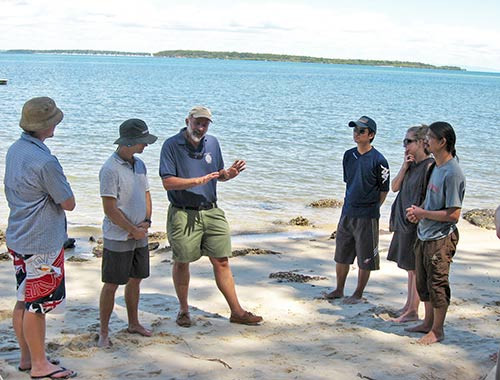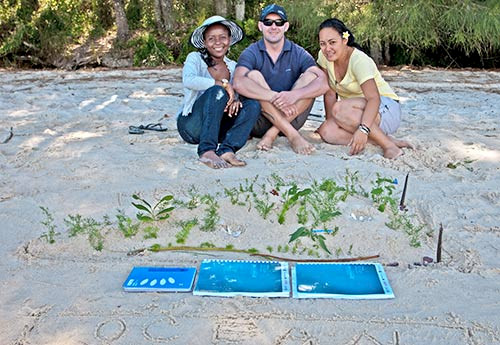Classifying environmental problems
Bill Dennison ·While on a field trip to Stradbroke Island as described in a previous blog, Dr. Brian McIntosh and I had a discussion about different types of environmental problems. I used the classification scheme of 'simple', 'complicated' and 'complex' problems (ala Glouberman and Zimmerman, 2002). Simple problems are like following a recipe in which a predictable set of results will reliably occur if the directions are faithfully followed. Complicated problems are like building a rocket to the moon in which difficult engineering and technical issues need to be overcome, but rather reliable results can be obtained. Complex problems are like raising a child where, regardless of the amount of effort that is expended, other factors can affect the results, and there is no reliable assurance of reproducible results. In the example of sand mining and water extraction from North Stradbroke Island, the hydrology and geomorphology issues could be considered complicated. In contrast, establishing the island's future with the continuation of sand mining or water extraction considering the social, economic and ecological impacts is complex. Complex problems typically involve the less predictable human element. In the coastal environmental realm, point source pollution could be viewed as simple (solution = sewage treatment), non-point or diffuse source pollution viewed as complicated (multiple solutions through best management practices) and climate change viewed as complex (potential solutions through mitigation and adaptation).

Brian, in turn, described the distinction between 'puzzles', 'problems' and 'messes' (ala Pidd, 2003). A puzzle is something where both the formulation and the solution are agreed upon. A problem is where the formulation is agreed upon, but the solutions are arguable. A mess is where both the formulation and the solution are arguable. In the Stradbroke Island example, the proponents of sand mining had very different perspectives of the key issues than the sand mining opponents and this could lead to a mess. When different perspectives lead to different formulation of what the issues, the different camps start to look at the same data with different interpretations.
Another way to contrast problems is to distinguish between 'tame' and 'wicked' problems (ala Churchman, 1973; Rittel & Webber, 1973). Wicked problems are those that are difficult or impossible to solve because of factors that change or are unrecognizable and are difficult to identify. Brian added that the process of defining a problem necessarily involves defining the kinds of solutions that can be applied, and this pre-determination of solution space narrows the options and could reduce the ability to ‘solve the problem’. The other feature about wicked problems is that in attempting to resolve them, other problems may be created. This concept has been expanded to 'super wicked' problems, which are those problems where time is running out, there is no central authority and those attempting to solve the problem are also creating it (ala Levin et al., 2007). In the Stradbroke Island example, the issue of managing resources like mineral sands and groundwater in the face of climate change could be viewed as a wicked problem, with some aspects becoming super wicked.

These different classification schemes all span a range of difficulty that could be equated with easy, hard and really hard. These schemes use examples and metaphors to contrast the different difficulty levels. While none of the schemes were developed for describing environmental problems, the degree of difficulty, regardless of the scheme classification scheme, often results in environmental problems being classified as complex problems, messes or wicked problems. Brian argues that ‘difficulty’ is not the right concept, as the difficulty could be manifested in different ways. Perhaps a better term would be whether the issue is ‘resolvable’; spanning easily resolvable to not easily resolvable.
Of the three terms referring to the least resolvable problems, I prefer the term 'complex problems', because the terms 'messes' and 'super wicked' frame the problem as less solvable. The metaphor of raising a child for difficult environmental problems is particularly poignant, both in the necessity of attempting to do the best to one's ability and in the incredibly rewarding nature of obtaining good results. On the other hand, I really like the symmetrical logic of the puzzle, problem and messes distinction. The role of scientist as ‘honest broker’ (Pielke, 2007) could be viewed as helping convert messes into solvable problems by framing the issues as a neutral third party.
There are many dimensions to environmental problem solving and developing a classification scheme can help employ triage on the problems that require scientific intervention. Some simple or tame problems don't need science, just implementation. Some complex or wicked problems could be messes that have a difficulty and risk that should be avoided. The mid-range difficulty may be the appropriate level for intervention with a reasonable chance for a positive outcome.
References
Churchman, C.W. 1967. Wicked problems, Management Science, Vol. 14:4
Glouberman, S. & Zimmerman, B. 2002. Complicated and complex systems: What would successful reform of health care look like? Romanow Papers: Changing health care in Canada. Paper 8.
Levin, K., Cashore B., Bernstein, S. & Auld, G. 2009. Playing it forward: Path dependency, progressive incrementalism, and the "Super Wicked" problem of global climate change. IOP Conf. Ser.: Earth Environ. Sci. 6 502002
Pielke, R, Jr. 2007. The honest broker: Making sense of science in policy and politics. Cambridge Univ. Press, 198 pp.
Pidd, M. 2003. Tools for thinking: Modelling in management science. 2nd ed. John Wiley & Sons. West Sussex, England. 319 pp.
Rittel, H. & Webber, M. 1973. Dilemmas in a general theory of planning. Policy Sciences, Vol. 4: 155-169.
About the author
Bill Dennison

Dr. Bill Dennison is a Professor of Marine Science and Vice President for Science Application at the University of Maryland Center for Environmental Science.

